THE HISTORY OF THE SA DAGGER
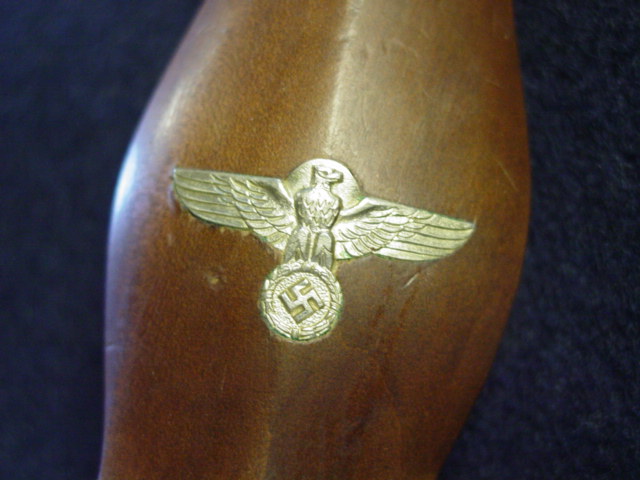
His goal was to overthrow the government, but he had to compete with numerous other Bavarian right-wing
groups and with his friend Ernst Roehm, a Bavarian staff officer. Roehm advocated the primacy of the military
and wanted to incorporate the party's paramilitary units, called the SA, or Storm Troopers (Sturmabteilung)
into his secret army, while Hitler insisted on the primacy of politics. Members of the SA were also
known as "Brown shirts".
In recognition for his important service to the SA, The Rohm dagger was created.
When the French occupied the Ruhr in
January 1923, German nationalist feelings ran high, and military authorities prepared for mobilization. The
views of Roehm and the other right-wingers now seemed to be prevailing; Hitler thereupon tried to regain control
of the movement by his Beer Hall Putsch of Nov. 8-9, 1923. The putsch was aimed at capturing, first, the
government of Bavaria, and then the nation's, but the Bavarian authorities were able to suppress it.
 Enlarge image (+)
Enlarge image (+)
|
In early 1934, however, he faced new conflicts, mainly from within the party. The SA, still led by Roehm,
and the Nazi left vigorously opposed his alliance with business and military leaders, and a group of
monarchists was campaigning for a restoration of the monarchy. Hindenburg's deteriorating health raised the
question of his succession. Hitler survived the crisis by adopting the most radical methods. He rallied behind
himself the party leaders, the army, and HIMMLER 's SS (the Schutzstaffel, or Blackshirts), and on June 30,
1934, he struck. A number of SA leaders, monarchists, and other opponents were murdered; the influence of the
SA was drastically reduced; This event came to be known as "The night of the Long Knives".
Hitler emerged as the undisputed master of Germany. When Hindenburg died on August 2, Hitler officially
assumed the title of Fuhrer, or supreme head of Germany. Beyond its political ramifications, this night
represents a milestone in the evolution of the SA dagger.
|
THE ORIGIN OF THE SA DAGGER
Hitler and the Nazi regime had an obsession with imagery and quality. This is reflected in the uniforms and
accutrements of the various organizations, military and paramilitary, created during this regime.
Blade weapons ave always captivated the imagination of people. Something about the sleek design and appearance
of edge weapons that makes these kind of items appealing to the masses, even today. Perhaps it is the remnants
of a time when our very survival depended on such things. Regardless of the reason, Hitler and his designers
capitalized in this feeling to make people feel better about belonging to a certain group. Daggers provided a
symbol as a unifying force to achieve a common goal.
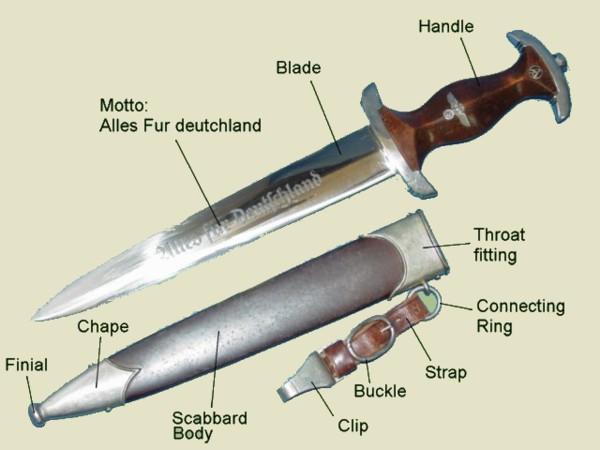
LARGE PRODUCTION NUMBERS
The SA dagger is the most widely produced dagger during Nazi Germany. Production numbers reached over 1 million.
At its peak Several mom and pop type shops emerged as manufacturers of the daggers. over
200 factories
manufactured and distributed the daggers.
In some cases the company would only produce a few pieces, like handles and handguards. They would purchase
the blade and scabbard from a different company. at assembly, they would stamp their own brand in the blade.
INTRODUCTION OF RZM
As the number of organizations grew, so did the number of types of daggers. Pretty soon it was clear that
this was a logistical nightmare. There were so many companies producing daggers and dagger parts but there
was no standards for them to follow. As long as the items looked correct they were produced and sold. The
problem is that parts among manufacturers were not interchangeable.
The solution to this problem was to implement construction standards. Sizes, colors, materials, etc. All of
it needed to be controlled. The standard that was created was known as
RZM.
This explains why today it is difficult to assamble a dagger from parts. For example, if you have a dagger
that is missing the handle. you find one for sale. the color and materials look good. You purchase it
and take it home just to find out it does not fit or that it fits poorly.
|
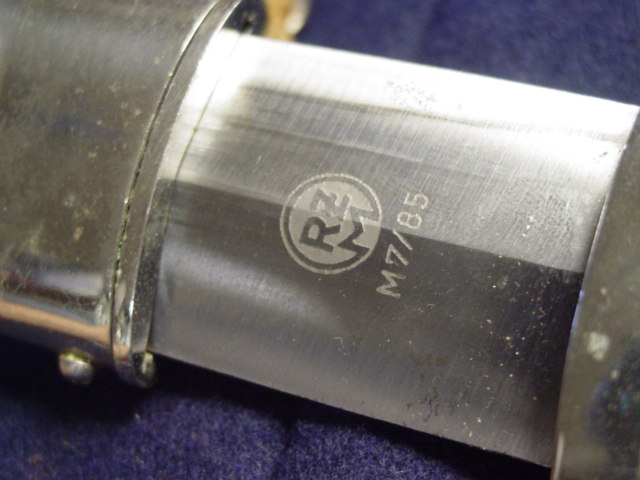 Enlarge image (+)
Enlarge image (+)
|
DISTRIBUTION POINTS
After a dagger was manufactured it had to be sent to distribution points where the SA members were able to
obtain the daggers. Special stores were set up as distribution points. Some of the stores were ran by
the manufacturer itself.
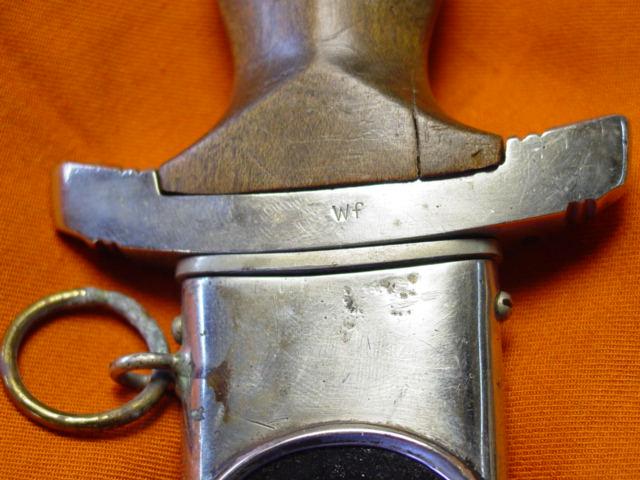 Enlarge image (+)
Enlarge image (+)
|
Each member of the SA was entitled to wear the dagger. However, each individual would have to pay for its
own dagger. In very much the same way as we do with cars today, a person could outfit the dagger with
various options. The old addage "you get what you pay for" applied here too.
District markings were struck on the handguard to denote the location from where the dagger was awarded.
The picture shown here displays a stamp of "wf". For additional information and a list of the markings used
visit our SA Markings section .
|
| WWII GERMAN SA DAGGER VARIATIONS |
There were multiple types of SA daggers that were produced during the Nazi reign. the variations covered here
are:
- Standard 1933 Pattern SA dagger
- SA Rohm dagger
- Marine SA dagger
- SA Honor dagger
- SA High Leader Honor dagger
- SA Feldherrnhalle dagger
- Post War Daggers
THE STANDARD 1933 PATTERN SA DAGGER
The 1933 SA model was the basic dagger that was issued
to all members of the SA. the example shown here has the single leather hanger. This dagger was produced in the
millions.
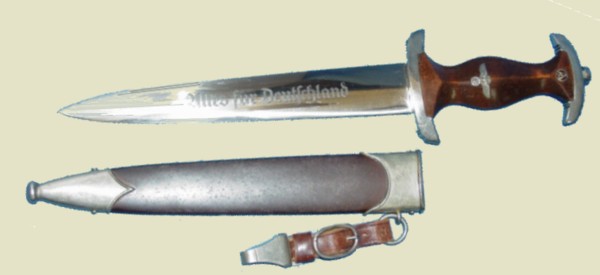
THE SA ROHM DAGGER
The Rohm dagger was created in order to recorgnize Ernst Rohm's great contributions to the SA. The dagger was
identical to the regular SA dagger except that it had the inscription "In Herzlicher Freundschaft Ernst Rohm",
which translated to "In heartfelt comradeship, Ernst Rohm", on the reverse of the blade. This dagger was
authorized on December 1931 and became known as the "Rohm" dagger. Around 100,000 samples were created for distribution
among its members.

Over the years Rohm's political views started to divert too far apart from Hitler's views. As a result, Hitler
charged Rohm with treason and ordered his execution (The night of the Long Knives). After this action took
place it was ordered that all Rohm daggers be eliminated from circulation. This was achieved in one of two ways;
The dagger could be destroyed or the special inscription could be taken off via grinder.

Having had to pay for the dagger, many members decided to go the grinder route instead of having to pay for
another dagger.
Dagger who still bear the entire Rohm dedication are hard to find.
Common manufacturers of the Rohm dagger include:
- Eickhorn
- EP&S
- F. Dick
- Henckels
- Wusthof
- Herder
- Aesculap
A few things to help determine the authenticity of Rohm daggers include:
- No RZM number should be present. These daggers were created before the RZM was instituted.
- The fittings should be nickel-silver instead of plated.
The Rohm dagger can be found in three primary states. With the Rohm inscription intact, this is the hardest to find.
With the Rohm name removed from the inscription (photo shown above). With the inscription completly removed, sometimes
even removing the manufacturer's logo. In some cases you can still make out some of the inscription at the end or the
edges when found in this last state.
MARINE SA DAGGER
The SA organization had a naval component. It was much smaller than the regular group. The members of the
Marine SA were authorized to wear a dagger in 1934. There were two models of marine SA daggers. They both were
patterned after the 1933 model with a few differences.
The first model displayed the following changes in relation to the 1933 model:
- Black annodized scabbard
- Black wooden handle withSA logo and eagle insert.
 The second model dagger consisted of the following characteristics:
The second model dagger consisted of the following characteristics:
- Brown scabbard
- Brown handle
- Copper or Brass fittings
SA HONOR DAGGER
The SA Honor dagger was issued by two different individuals; Ernst Rohm and his successor, Victor Lutze.
Rohm was more flexible with the criteria for awarding the dagger. He issued a fairly large number of them.
When Lutze took over command of the SA he tightened the criteria. Most of the people who got them under his
command were high ranking officers.
There was no standardization of the production of the Honor dagger. Therefore multiple configurations of it exist.
The design was based on the 1933 model. some of the changes included an embellished hilt and crossguard.
These pieces were adorned with oakleaf reliefs. The same treatment was afforded to the scabbard fittings.
However, some of the scabbards had plain fittings as well.
The early daggers were outfitted with Damascus blades. The motto "Alles fur Deutchland" was applied to one
side of the blade. Sometimes the motto was executed in gold relief.
The scabbard could come as standard issue or have a brown leather wrap. The hanger consisted of the plain brown
leather strap.
THE HIGH LEADER HONOR DAGGER
The SA High Leader Honor dagger
was introduced in 1938 and was based on the presentation dagger given to the
new head of the SA, Victor Lutze. This new dagger was different from the regular Honor dagger in that it was
standardize. It had a very specific set of measurements and configurations for its production. It was not
simply based on the 1933 model dagger.
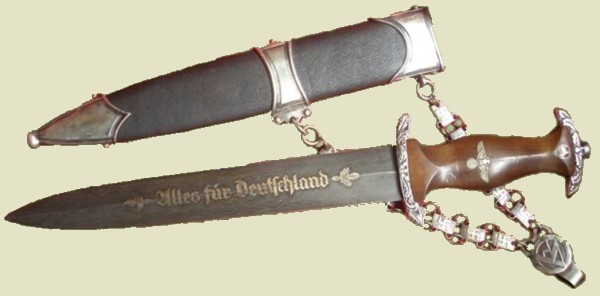
The criteria for awarding the dagger was far more strict than the regular Honor dagger. It was limited to
high leaders. However, achieving the title of high leader did not automatically imply that the person
was awarded the dagger. The person had to excel in the execution of his duties, hence the name "Honor"
dagger. In addition, the dagger could only be awarded by Victor Lutze himself.
The design of the High Leader dagger was very similar to that of the Honor dagger. The biggest difference was
the suspension chain. Which had a series of plates bearing the Swastika in the front. Each plate was attached
to each other via the use of two loops. The chains attached to a large silver clip that had the SA symbol
executed in relief.
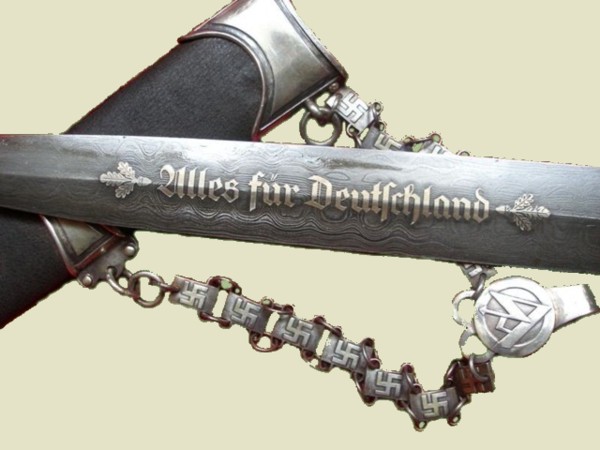
The handle is made of wood. The SA logo is incrusted in the upper section. A silver eagle is placed near
the center of the handle. The hilt and crossguard are decorated with oakleaves and acorns. The blade
is done in Damascus with the motto "Alles fur Deutchland" in gold placed on one side. The other side has the
manufacturer's logo also done in gold.
The scabbard is of metal construction. The main body is wrapped in leather. Three fittings are present.
They are of silver color. The center and upper sections have suspension rings where the chain attaches.
The center fitting has a more robust suspension system.
The High Leader Honor dagger was produced exclusively by the Carl Eickhorn company.
THE SA FELDHERRNHALLE DAGGER
The chief the SA, Viktor Lutze, developed a special force of bodyguards in 1936. This elite group was
formed of full time SA professionals and was similar inconcept as the early days of the SS, which was
created to provide Hitler with security.
The name "Feldherrnhalle" was adopted in recognition of the place where Adolf Hitler first attempted to
take control of Germany via the use of force. The Feldherrnhalle was the name of a monument. Hitler's
forces engaged in a gun battle with police at this location. As a result several people were killed and
wounded. Among the wounded was Herman Goering who would later become head of the Luftwaffe. The
Feldherrnhalle mounment became a nazi shrine.
At the start of its existance, members of the Feldherrnhalle wore the standard SA model 1933 dagger or the
Feldjager bayonet. In 1937, a special dagger was authorized for use for leaders of the Feldherrnhalle
and members of Lutze's staff.
It is not clear how many of these daggers were made. It is believed that the number hovers at around
fifty.
The dagger is very different in appearance from all other employed by the SA. It was designed by
well known artist Paul casberg. Manufactured exclusively by the Carl Eikhorn company. The blade
was similar in design as the Army blade. The center section was flat and displayed the motto
"Alles fur Deutchland". The other side of the blade had the manufacturer's logo, which was the
Eickhorn squirrell employed between 1935 and 1941.
POST WAR PRODUCTION
At the end of the war most German cities were virtually destroyed. Daily life Things that were once taken
for granted became difficult things to achieve. Chief among the worries was how to make a living.
As the ranks of the GI's swelled with fresh troops arriving from the States to perform the duties of
an occupation force, a new industry was being created, selling souvenirs to soldiers who had money to spend.
Factories who had left over stock of daggers and parts saw a golden opportunity. They started assembling
dagger to sell to the GI's. It is generally believed that this practice took place primarily between the
years of 1946 and 1948. By 1951 the use of the swastika was banned in Germany. Therefore eliminating
production of daggers.
The SA dagger was one of the daggers known to fall in the category of post-war production pieces. Other daggers
include the SS version and the Hitler Youth Knife.
|
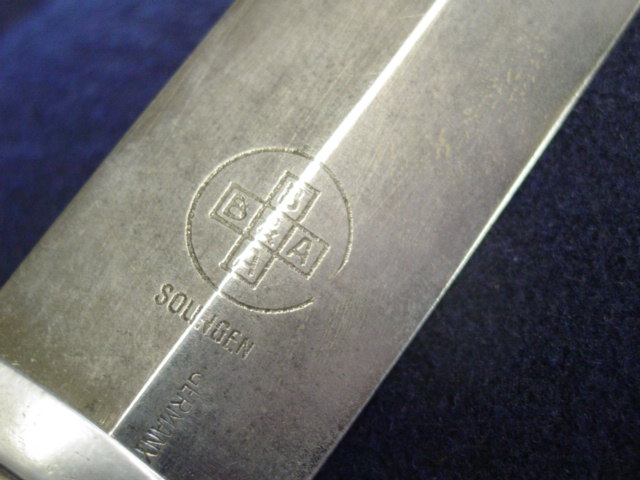 Enlarge image (+)
Enlarge image (+)
|
The post-war production SA dagger usually was sold without a scabbard. The manufacturer would be BSA, whose
symbol was a cross with the letters BSA going from top to bottom as well as left to right. The blade was
manufactured in the town of Solingen. The word "Germany" is also stamped on the blade.

Note that only post-war production daggers have the word "Germany" stamped on them. This practice was not
observed in the daggers manufactured during war time.
SA DAGGER REPRODUCTIONS
Like many other German WWII items, the SA dagger has been reproduced for several years. There is nothing
wrong with buying and selling reproductions. As long as both parties know that the items is not real. The
problem occurs when the items are misrepresented as real when they are not.
There are several countries producing replicas of the SA dagger. The most common are China, India and Pakistan.
Spain produced several dagger reproductions in the 1950's and 1960's. The quality of the reproductions will vary.
some of them are very good while others are not. Ususally the price point dictates the quality of the item.
Paying close attention to the details of construction and materials is the best way to detect reproductions.
| WWII GERMAN SA DAGGER EXAMPLES |
The more examples of a particular dagger that are examined the more knowledge is gained about the
particular piece. Differences in construction can be better appreciated. Markings on the blade and other
sections are better understood. The overall knowledge about the dagger is expanded.
This section of the site provides several examples of the dagger.
INTERESTED IN BUYING OR SELLING AN SA DAGGER?
Visit the
"German WWII -> Daggers and Parts"
section of our store to see the available inventory. All items there have a money-back guarantee to be original,
unless otherwise stated. You can buy from us with confidence.
Fell free to contact us. We will make you an offer for a single item or an entire collection.
Page 1
Continued - The history of the SA dagger

While the item featured here is not for sale, similar items like it are available for
purchase in our website MilitaryItems.com
|





